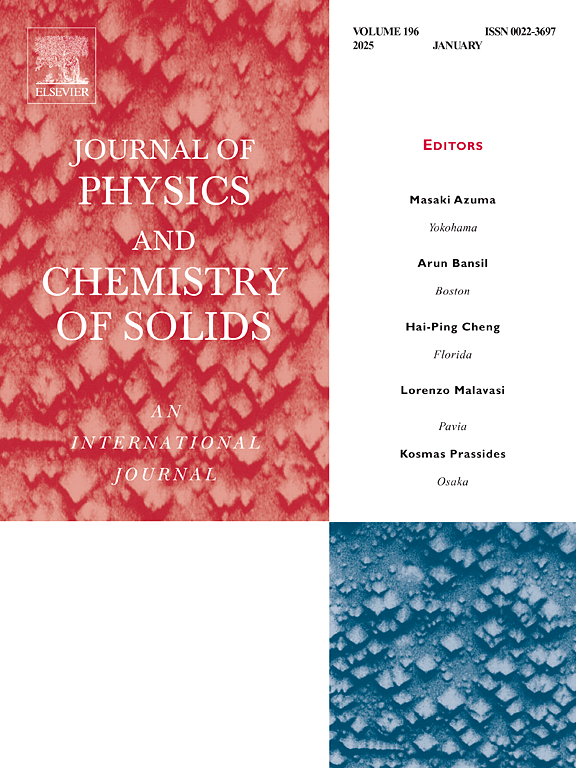研究了在残余氧存在下增加N2/(Ar+N2)气体流量比对反应溅射沉积非晶Al-O-N合金薄膜磁性能的影响
IF 4.9
3区 材料科学
Q2 CHEMISTRY, MULTIDISCIPLINARY
引用次数: 0
摘要
本文报道了在残余氧存在下,增加N2/(Ar + N2)气体流量比对反应溅射沉积非晶Al-O-N合金薄膜磁性能的影响。在残余氧存在的情况下,采用Ar/N2混合气体,分别增加N2/(Ar + N2)气体流量比为10%、20%和50%,通过反应溅射法制备了非晶Al-O-N合金薄膜。显微结构分析证实,这三种薄膜均表现出非晶态的近程有序特性。化学分析表明,一部分铝与氮反应生成AlN,而剩余的膜主要由Al(NOy)x相组成,含有氧空位(OV)位点。在300 K时,这三种薄膜都表现出超顺磁性(SPM)行为,表明存在纳米级单畴磁性颗粒。然而,N2/(Ar + N2)气体流量比的增加系统地提高了薄膜的体饱和磁化强度和磁性体积分数。这种增强与含有OV位点的Al(NOy)x相形成的增加密切相关。这些发现表明,Al(NOy)x相内的氧空位在300K下Al - o - n合金薄膜的磁性诱导中起着关键作用,可以通过控制溅射沉积过程中N2/(Ar + N2)的流动比来调整。因此,本研究为通过精确控制沉积条件,特别是残余氧存在下的气体流量比来定制非晶Al-O-N合金薄膜的磁性提供了新的见解。本文章由计算机程序翻译,如有差异,请以英文原文为准。

Investigating the impact of increasing the N2/(Ar+N2) gas flow ratio in the presence of residual oxygen on magnetic properties of reactively sputter-deposited thin films of amorphous Al–O–N alloy
In the present work, we have reported the impact of increasing N2/(Ar + N2) gas flow ratio in the presence of residual oxygen on the magnetic properties of reactively sputter-deposited thin films of amorphous Al–O–N alloy. Amorphous Al–O–N alloy thin films were deposited via reactive sputtering of an aluminum target in the presence of residual oxygen, using an Ar/N2 gas mixture with increasing N2/(Ar + N2) gas flow ratios of 10 %, 20 %, and 50 %, respectively. Microstructural analysis confirms that all three films exhibit amorphous characteristics with short-range ordering. Chemical analysis indicates that a portion of aluminum reacts with nitrogen to form AlN, while the remaining film primarily consists of the Al(NOy)x phase, containing oxygen vacancy (OV) sites. At 300 K, all three films display superparamagnetic (SPM) behavior, indicating the presence of nano-scale single-domain magnetic particles. However, an increase in the N2/(Ar + N2) gas flow ratio systematically enhances both the bulk saturation magnetization and the magnetic volume fraction in the films. This enhancement correlates well with the increased formation of the Al(NOy)x phase containing OV sites. These findings suggest that oxygen vacancies within the Al(NOy)x phase play a key role in inducing magnetism in Al–O–N alloy thin films at 300K that can be tailored by manipulating the N2/(Ar + N2) flow ratios during sputter deposition. Therefore, the present study provides a new insight into tailoring the magnetic properties of amorphous Al-O-N alloy thin films by precisely controlling the deposition conditions, particularly the gas flow ratio in the presence of residual oxygen.
求助全文
通过发布文献求助,成功后即可免费获取论文全文。
去求助
来源期刊
CiteScore
7.80
自引率
2.50%
发文量
605
审稿时长
40 days
期刊介绍:
The Journal of Physics and Chemistry of Solids is a well-established international medium for publication of archival research in condensed matter and materials sciences. Areas of interest broadly include experimental and theoretical research on electronic, magnetic, spectroscopic and structural properties as well as the statistical mechanics and thermodynamics of materials. The focus is on gaining physical and chemical insight into the properties and potential applications of condensed matter systems.
Within the broad scope of the journal, beyond regular contributions, the editors have identified submissions in the following areas of physics and chemistry of solids to be of special current interest to the journal:
Low-dimensional systems
Exotic states of quantum electron matter including topological phases
Energy conversion and storage
Interfaces, nanoparticles and catalysts.

 求助内容:
求助内容: 应助结果提醒方式:
应助结果提醒方式:


